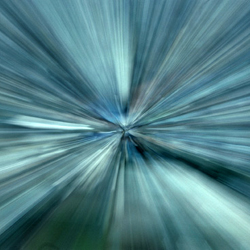Straddling a Speeding Proton

Protons undergoing acceleration either decay or collide, depending on your perspective, according to a paper in the 8 October print issue of PRL. The authors show that an observer who’s standing still will see an accelerating proton “spontaneously” decay, while an observer riding with the proton will see it collide with a particle that doesn’t exist in the stationary observer’s world. Both perspectives are not only accurate–they are required by quantum field theory, say the authors. The agreement between these seemingly conflicting views is the strongest evidence yet for an odd phenomenon called the Fulling-Davies-Unruh (FDU) effect.
“Almost everything possible is compulsory in particle physics,” explains George Matsas of São Paulo State University (SPSU) in Brazil. So the normally stable proton can decay into a neutron, a positron, and a neutrino if continuously fed enough energy through constant, extreme acceleration. Since the mid-1960s theorists have predicted that an accelerating proton could decay quickly, but Matsas, and his SPSU colleague Daniel Vanzella, had a problem with this prediction: What would you see if you were riding atop the proton? From that perspective, Vanzella explains, the proton would appear to be standing still and should not decay.
As a solution to this paradox, Vanzella and Matsas evoked a quirk of quantum field theory–the FDU effect. According to the FDU effect, an observer undergoing extreme acceleration will be immersed in a thermal bath of protons, neutrons, electrons, and other particles. These particles appear because of the observer’s acceleration. The effect’s complex calculations and counterintuitive results have caused some skepticism, but Vanzella and Matsas believed it was the only solution to their problem of perspective.
With effect in hand, Vanzella and Matsas calculated the probability that an accelerating proton would–from its own point of view–collide with one of the particles resulting from its acceleration. Adding up the probabilities of the various collisions, the duo found that the proton would collide at exactly the same time that a stationary observer would see it decay. This result, they claim, provides strong proof that the FDU effect is real.
“It’s bizarre,” says Alan Kostelecky of Indiana University in Bloomington. “But the effect is there, and I’m convinced of it.” Kostelecky doubts that particle physicists will actually observe the FDU effect, because the acceleration required is enormous. But it may be possible to see the results in certain astrophysical phenomena, he says.
–Geoff Brumfiel


